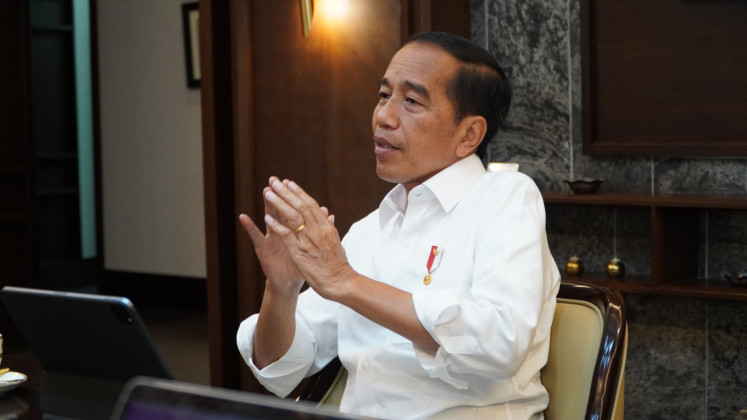Tough choices for the rupiah
Further depreciation of the rupiah would eventually put our inflation rate and economic growth at great risk, given the impact of imported inflation.
Change Size
 A woman displays new rupiah bills at a money exchange counter in Lembupeteng sports hall, Tulungagung, East Java, on March 28, 2024. (Antara/Destyan Sujarwoko)
A woman displays new rupiah bills at a money exchange counter in Lembupeteng sports hall, Tulungagung, East Java, on March 28, 2024. (Antara/Destyan Sujarwoko)
T
he changing tide of the rupiah's interaction with the United States dollar has put Bank Indonesia (RI) between a rock and a hard place.
In the past few days, our currency has passed a multiyear low to hit between Rp 16,200 and Rp 16,300 to the dollar, after the US Federal Reserve signaled its intention to keep interest rates higher for longer amid heightened geopolitical tensions, particularly in the Middle East, where Iran has entered the fray in the Israel-Hamas conflict.
Now it is almost as bad as in early 2020, when the rupiah hit 16,640 against the greenback amid the COVID-19 pandemic. Analysts have suggested that the currency may breach the historic low of Rp 16,950 to the dollar, set during the 1998 Asian Financial Crisis.
We were supposed to see a light at the end of the tunnel this year, with hopes that BI could lower interest rates in the second half, as we expected the Fed would give us the room to do so.
The macroeconomic data may actually justify rate cuts. Inflation has remained low and within the central bank’s target range of 2.5±1 percent in the past months, while economic growth has been within the desired area of around 5 percent.
BI may have all the room to start cutting rates this year from a domestic perspective, but the central bank may not want to. We might not want to risk it.
The US economy has proven too strong for now for the Fed to make a cut, as shown by the country’s stubbornly high inflation. The dollar is now the talk of the town, and a rate cut would only drag the rupiah down further, which is the last thing we want to see.
Further depreciation of the rupiah would eventually put our inflation rate and economic growth at great risk, given the impact of imported inflation. This includes our fiscal stability, as a result of its role in absorbing economic shocks through subsidies.
We may need to consider the circumstances of the many corporations relying on foreign debt to sustain their businesses, as things could get even more troublesome if a depreciating currency made those repayments more costly.
Our foreign exchange reserves have continued to decline, reaching $140 billion in March, down from $146 billion in December 2023.
Ideally, we will be able to keep the rupiah on its feet without having to rely on the benchmark rate, as BI has often reminded us it is not the only medicine in the cupboard.
But we may need to accept that the benchmark rate could be the only thing keeping everything intact, especially given our battered exports amid weakened global demand, falling commodity prices and our shallow financial system that fails to convince Indonesia’s rich, some with billions of dollars, to keep their money onshore.
It is true that Indonesia has introduced means to keep export receipts onshore, which in theory should help the country build its foreign reserves, especially of dollars, but the policy still needs improvement, as businesses and policymakers have not been seeing eye to eye.
Usually, central banks will follow the Fed’s lead, but this time around, some may pursue a divergent path.
The European Central Bank has signaled that its first cut will be soon, as have some other central banks, despite the Fed’s indication that its own rate cut will likely come much later than expected. Investors believe it may not happen until March of next year.
If BI decides to wait longer before cutting rates, we may have to believe it is for the best.
While some analysts have suggested that BI consider making another hike, we must hope for now that BI has what it takes to maintain the rupiah’s stability and manage market sentiment about our currency with all the tools at its disposal.










